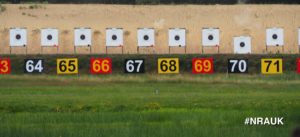
Introduction
Fullbore target rifle shooting is one of the oldest shooting disciplines in the world with its origins dating back to the very foundation of the National Rifle Association in 1860. In this discipline, shooters fire from the prone position (lying down) and typically compete over distances ranging from 300 yards to 1000 yards. They shoot at a circular target with concentric scoring rings using the marksmanship principles of a stable position, natural alignment and smooth trigger control to try and ensure that all their shots fall as close to the centre as possible. However, the shooters are also exposed to the elements and as well as having good technique, they must also judge the changes in wind strength and direction in order to maximise their score. All of this whilst steadying their nerves and maintaining composure under the pressure of competition.
Equipment
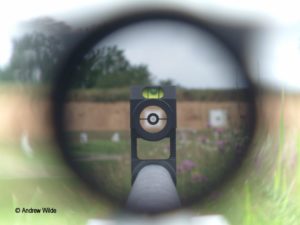
For fullbore target rifle, competitors use single shot bolt action rifles that are similar in design to small bore rifles. The key difference being the calibre which is 7.62 mm (.308″). This enables them to shoot higher powered rounds that are necessary to shoot over the much longer distances. Despite the long distances involved, in target rifle telescopic sights are not allowed and competitors must use open iron sights. Shooters take aim by centralising the circular aiming mark in the middle of their foresight as shown. As well as not being allowed telescopic sights, shooters are also not allowed to use a rest and must support the weight of the rifle themselves. Their only support is a sling attaching the rifle to their arm and helping them to maintain a steady position.
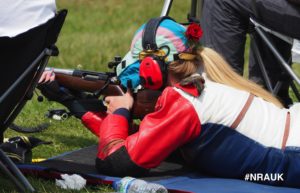 After the rifle itself the next most important piece of equipment is a good set of ear defenders. Due to the calibre of ammunition used, fullbore target rifles produce a very loud bang so good hearing protection is essential. The next item is a shooting jacket, these are usually made from thick leather or canvas. They provide padding for the shoulder and elbows to cushion against the recoil of the rifle and grippy sections on the elbows prevent the position from slipping during a shoot. A good jacket also provides overall stability and support to the shooters position. The jacket is usually paired with a matt for the shooter to lye on which also has grippy material to help maintain the shooters position. The final crucial piece of equipment is a spotting scope which is used by the shooter to see where their shot landed on the target but can also be used to observe changes in mirage (heat haze) that can be used to judge the wind. As well as these essential items most shooters usually have a range of other small pieces of equipment including a hat to shade the sights from the sun and glove to provide padding against recoil and a score book with plotting diagrams to record the progress of their shoot.
After the rifle itself the next most important piece of equipment is a good set of ear defenders. Due to the calibre of ammunition used, fullbore target rifles produce a very loud bang so good hearing protection is essential. The next item is a shooting jacket, these are usually made from thick leather or canvas. They provide padding for the shoulder and elbows to cushion against the recoil of the rifle and grippy sections on the elbows prevent the position from slipping during a shoot. A good jacket also provides overall stability and support to the shooters position. The jacket is usually paired with a matt for the shooter to lye on which also has grippy material to help maintain the shooters position. The final crucial piece of equipment is a spotting scope which is used by the shooter to see where their shot landed on the target but can also be used to observe changes in mirage (heat haze) that can be used to judge the wind. As well as these essential items most shooters usually have a range of other small pieces of equipment including a hat to shade the sights from the sun and glove to provide padding against recoil and a score book with plotting diagrams to record the progress of their shoot.
Individual Shooting
Once a new shooter has taken up the sport and has been to a number of club practice weekends they may start to think about entering competitions. These can consist of either individual or team events and are available for all ability levels from small inter-club competitions to international events. In individual shooting, as one might expect, the firer has to do everything themselves not only taking the shot but also judging the wind and keeping an accurate plot of their shoot. The format of individual shooting can vary around the world but in the UK, shooters are typically arranged in groups of 3 firers sharing a single target. Firers each fire one shot in turn before going back to the beginning and firing their next shot. This leaves time for them to make wind calls and keep their plot between shots. Each firer will also be expected to register keep for the person who fires after them, keeping a note of that shooters score for the competition and checking their rifle is safe at the end of the shoot. Firers get 45 seconds per shot and competitions typically vary between 7, 10 and 15 round shoots. Individual competitions are often held at multiple distances with their score at each distance contributing to an aggregate score.
Team Shooting
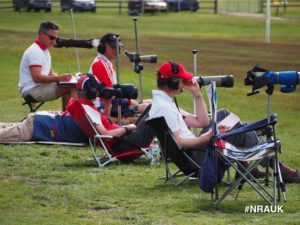 Team shooting is similar except that this time the key skills of shooting, wind reading and plotting are located to different team members who must work together to achieve the best score. In a typical team match a dedicated wind coach will be chosen for each target who’s role is to make sight adjustments for the changes in wind and also tell the shooter when to fire and when to wait. The shooters role is to fire well aimed shots as and when they are asked by the wind coach. The role of the plotter is to keep a record of the score and to centre the group, they are pay particular attention to the shooters elevation but can also support the wind coach in centring the wind call to maximise the score. Each member of the target team must work seamlessly together in order to get the best results and at international level there is a strong bond of trust that forms between each member of the team.
Team shooting is similar except that this time the key skills of shooting, wind reading and plotting are located to different team members who must work together to achieve the best score. In a typical team match a dedicated wind coach will be chosen for each target who’s role is to make sight adjustments for the changes in wind and also tell the shooter when to fire and when to wait. The shooters role is to fire well aimed shots as and when they are asked by the wind coach. The role of the plotter is to keep a record of the score and to centre the group, they are pay particular attention to the shooters elevation but can also support the wind coach in centring the wind call to maximise the score. Each member of the target team must work seamlessly together in order to get the best results and at international level there is a strong bond of trust that forms between each member of the team.
Team matches can vary significantly in format ranging from small single target teams with just 4 firers to much larger teams such as the national match consisting of 5 targets and 20 firers. In these more complex matches there is often a main coach who leads communication and strategy across all the targets so that the team as a whole is working together. Like in individual events, team matches are very often held over multiple distances with matches taking place at either short range (300, 500 and 600 yards) long range (800, 900 and 1000 yards) or a combination of both. Unlike in individual events, the shooter does not have to firer within just 45 seconds, in this case there is typically a time limit for each distance (e.g. 1 hour) and all the firers must have completed their shoot within this allowed time. This adds another dimension to the tactics of team shooting as the coach must decide whether to take a risk shooting in changeable wind conditions or wait and give the firers less time but with steadier conditions.
Events
As mentioned there are a huge number of events both for individual shooting and team shooting. In the UK target rifle events are typically held during the months from April to October with some form of event taking place on almost every weekend. The majority of larger events are held at Bisley due to the size of the ranges their and the easiness with which targets can be booked. However, there are also many events organised by local clubs held on ranges around the UK such as at Altcar near Liverpool, Blair Athol in Scotland and smaller ranges in Cornwall, East Anglia and Yorkshire to name but a few. Events themselves can range from small club events to much larger national and international affairs. Most clubs will host an Open Prize Meeting, usually consisting of a series of individual competitions open to members and non-members over the course of a weekend. Most clubs will also have their own program of inter-club fixtures spread throughout the season. The English Twenty Club is no different and you can find out more about our series of events under the competitions menu or the events page.
At county level, individual counties may organise their own Open Prize meetings and fixtures with other local counties, however there are 3 main inter county competitions that are organised nationally. The NRA Inter-counties meeting and the County Short and Long competitions are both organised by the NRA. The English Twenty Club organises its own inter-county event called the King George V Challenge. This is different to the others in that counties compete in regional heats which are usually held on a local range in the region. The winners of the heats then go forward to compete in a final at Bisley each year.
Without a doubt the biggest event of the season, and one of the largest shooting events in the world is the NRA’s Imperial meeting. This is held every year in July at the National Shooting Centre Bisley. This event encompasses all shooting disciplines but for target rifle the event lasts for nine days. Over the course of the week shooters compete against each other in a large number of individual competitions and aggregates that contribute to their score in the prestigious Grand Aggregate. As well as this shooters compete for the world renowned Her Majesty the Queen’s prize, arguably the most famous and prestigious competition in the world. There are often in excess of 1000 entrants which are whittled down to a final of just 100 shooters who battle for the prize.
National and International Shooting
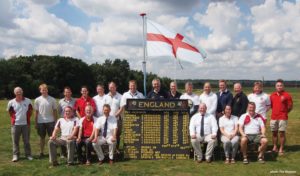 As well as individual events, the NRA’s imperial meeting also consists of both national and international team matches and attracts visitations from overseas teams including Australia, Canada, Channel Islands, South Africa, Kenya, USA, Malaysia and New Zealand. The National Match is one of the largest matches taking place between teams of 20 firers from England, Ireland, Scotland and Wales and is shot at short range. The Mackinnon Match is an international match for teams of 12 firers from England, Ireland, Scotland, Wales and any visiting overseas team and it is shot at long range. The other international match is the Kolapore which is for a team of 8 representing Great Britain against any visiting overseas teams and it is also shot at short range.
As well as individual events, the NRA’s imperial meeting also consists of both national and international team matches and attracts visitations from overseas teams including Australia, Canada, Channel Islands, South Africa, Kenya, USA, Malaysia and New Zealand. The National Match is one of the largest matches taking place between teams of 20 firers from England, Ireland, Scotland and Wales and is shot at short range. The Mackinnon Match is an international match for teams of 12 firers from England, Ireland, Scotland, Wales and any visiting overseas team and it is shot at long range. The other international match is the Kolapore which is for a team of 8 representing Great Britain against any visiting overseas teams and it is also shot at short range.
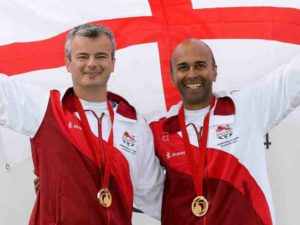 Beyond these 3 annual matches there are many other opportunities to compete at National and International level through being selected for overseas teams which travel around the world to compete in other countries major events. You can read more about the tours organised by the English Twenty Club on the Tour section of this site. By far the pinnacle of international shooting are the World Championships and the Commonwealth Games. These events take place every four years. The World Championships is competed for by a team from Great Britain selected by the NRA. Whilst the Commonwealth Games is competed for by pairs from each home nation and the England pair is selected by the English Twenty Club.
Beyond these 3 annual matches there are many other opportunities to compete at National and International level through being selected for overseas teams which travel around the world to compete in other countries major events. You can read more about the tours organised by the English Twenty Club on the Tour section of this site. By far the pinnacle of international shooting are the World Championships and the Commonwealth Games. These events take place every four years. The World Championships is competed for by a team from Great Britain selected by the NRA. Whilst the Commonwealth Games is competed for by pairs from each home nation and the England pair is selected by the English Twenty Club.
